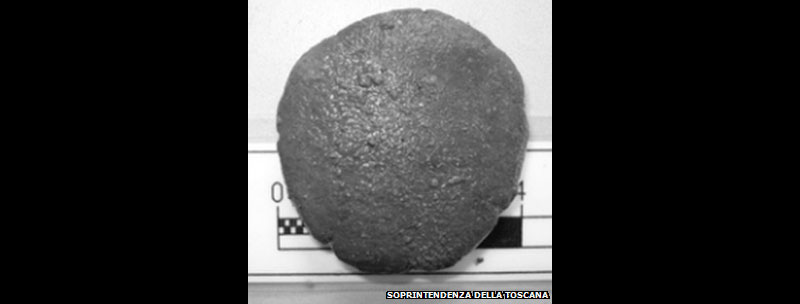January 7, 2013 | BBC NEWS Science & Environment | By Rebecca Morelle | Science reporter, BBC World Service

Medicine that is more than 2,000 years old has been analyzed by scientists.
Six tablets were discovered in a tin box on-board an ancient Roman shipwreck, found off the coast of Italy.
Samples of the fragile material revealed that the pharmaceuticals contained animal and plant fats, pine resin and zinc compounds.
Writing in the Proceedings of the National Academy of Sciences, the researchers said the medicine might have been used to treat eye infections.
“I am surprised by the fact we have found so many ingredients and they were very well preserved considering it was under water for so much time,” said Maria Perla Colombini, professor of chemistry from the University of Pisa.
The shipwreck that the tablets were found on dates to 140-130 BC, and was thought to have been a trading ship sailing from Greece across the Mediterranean.
It was first discovered in 1974 off the coast of Tuscany, and explored during the 1980s and 1990s, but it is only now that the tablets have been fully investigated.
“We used a very thin scalpel to detach a small flake of substance to be analyzed,” explained Professor Maria Perla.
Mass spectrometry revealed the tablets contained an array of ingredients.
The team found pine resin, which has antibacterial properties. Animal and vegetable fats were also detected, among them possibly olive oil which is known for its use in ancient perfumes and medicinal preparations.
They also found starch, which is thought to be an ingredient in early Roman cosmetics. The team also discovered zinc compounds, which they think may have been the active ingredient in the tablets.
Given the composition of the medicine, the team believe it could have had an ophthalmic use.
Ancient writings
Finding ancient medicines is rare, especially those in as good condition as the Pozzino tablets.
Much of our understanding of the early medical world comes from writings from the time.
Gianna Giachi, from the Superintendence for the Archaeological Heritage of Tuscany, said: “We compared our results with what the ancient authors wrote, including Theophrastus (from 371-286 BC), Pliny the Elder and Dioscorides (both from the 1st Century AD) and we highlighted a large correspondence with the ancient ingredients – especially for the use of zinc compounds.
“In addition, recent scientific literature documents the utilization in Roman pharmacology of zinc compounds, especially for the preparation of powder used for the treatment of eyes diseases.”
She added that the study, which also involved work by scientists from the University of Florence’s biology department, would help to shed more light on the ancient pharmaceutical world, which was surprisingly sophisticated.
“The research highlights the care, even in ancient times, in the choice of the complex mixture of products in order to get the desired therapeutic effect and to help in the preparation and application of the same medicine,” Dr Giachi said.
In an earlier study of the tablets, a US team carried out a genetic analysis of the plant material in the tablets.
Robert Fleischer, from the Smithsonian’s Center for Conservation and Evolutionary Genetics, found plant extracts including carrot, radish and parsley, which suggested the tablets could have been used for gastrointestinal trouble.



